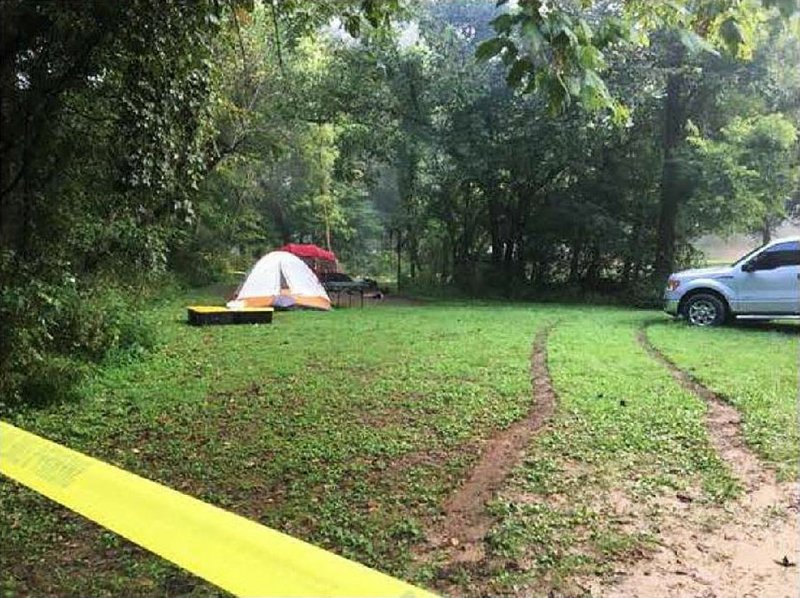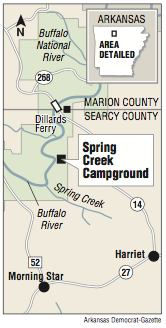The Buffalo National River ranger who fatally shot Jonathan Bolger on Aug. 20, 2017, said he wanted to shoot sooner.
The park ranger, who hasn't been publicly identified, told federal investigators that he would have shot when Bolger pointed a gun at his partner, but in the heat and darkness of a sudden, tense standoff, the ranger forgot he had a flashlight in his left hand, so he couldn't get a two-handed grip on his .40-caliber pistol.
"I remember wanting to take the shot way earlier," the ranger told investigators Aug. 25, 2017. "As I'm trying to put my hands together, I remember the flashlight, that big flashlight, being in my left hand and my service pistol being in my right hand, and I couldn't put 'em together in my head. I was trying to figure out why I couldn't get a grip on my gun."
Seconds later, the ranger thought Bolger was turning toward him to shoot, according to the 1,106-page investigative report, which was recently released after a request was filed under the federal Freedom of Information Act.
At least twice, the two rangers had identified themselves as police, and Bolger had asked to see their badges, reports say.
"I dropped my flashlight at that point in time to get rid of it," the ranger told investigators. "I got both hands on the gun. And the suspect was walking backwards. I remember him saying ... 'No, show me your badge.' And at that point again, I yelled, 'Police, drop the gun. Police, drop the gun,' as I'm still moving to my right and he's still backing up. And then suddenly and quickly, he turns towards me and raises both his arms at me with the gun still in his left hand. At that point, I fired."
The ranger fired four shots, three of which hit Bolger, 34, of Branson, who died at the Spring Creek Campground.
"I did it because I thought he was going to shoot me," the ranger told investigators.
After the shooting, the rangers discovered that Bolger had a BB gun in his hand.
Bolger was camping at Spring Creek with his girlfriend, Ashley Santoro, and her three children.
Santoro told investigators that Bolger didn't point the BB gun at the rangers.
"He never raised his gun the whole time," she told police. "He had it down by his side. ... All he asked him was to see his badge. That's all he wanted to do. But he didn't. I don't know why he just didn't drop it. I don't know."
Both rangers told investigators that Bolger pointed the gun at them. The Umarex air pistol didn't have an orange tip to identify it as a BB gun, according to the report.
A federal investigation into the shooting ended July 25 with no charges filed against the ranger. A news release from U.S. Attorney Duane Kees said there was "insufficient evidence to prove beyond a reasonable doubt that the rangers used excessive force or violated federal laws under the circumstances."
An Arkansas prosecutor announced in January that he wouldn't file state charges in the case.
Few details about the shooting had been revealed while it was under investigation. It was one of seven officer-involved shootings by National Park Service rangers over the past 10 years, said Alexandra Picavet, chief of communications for the National Park Service's Midwest Region office in Omaha, Neb. Three people died in those shootings, including Bolger.
Two rangers were at the Spring Creek Campground during the shooting. Only one fired shots. They have not been identified, in accordance with National Park Service policy. Their names were redacted from the investigative report.
The rangers were on a late-night patrol of campgrounds. They parked their pickup down the road and walked to the campsites so as not to disturb sleeping campers, according to the report.
Bolger pointed a bright flashlight at the rangers and yelled "Who's over there?" according to the report.
The situation escalated from there, with Bolger turning off his flashlight and the rangers illuminating him with theirs.
Both rangers were in uniform. The veteran ranger was wearing a metal badge. The other ranger, a trainee, had a gold cloth badge sewn onto his shirt.
During the verbal exchange with Bolger, the rangers separated, and the veteran ranger walked along the road by the campsite.
A body camera worn by the veteran ranger captured a few seconds before the shooting. There are 12 still images in the investigative report, covering about 12 seconds before the shooting. The images show Bolger lifting his right arm to shield his eyes from the rangers' flashlights. The driver's door of his four-door Ford F-150 pickup is right behind him.
"The video footage ... shows Mr. Bolger most likely had the BB gun in his left hand," according to a synopsis in the report. "It shows Mr. Bolger turn towards his left and raise his right arm in the direction of [the veteran ranger]. It then shows Mr. Bolger's right arm and hand move towards the driver's side front door of his vehicle. [The veteran ranger] shot Mr. Bolger when his right arm was raised and was moving towards the front door of the vehicle."
Above the second-to-last video still image, the description reads: "Mr. Bolger grabs the front driver's side door handle with his right hand."
In the next frame, Bolger is on the ground.
"The front driver's side door has been opened, which activated the rear taillights of the truck," according to the report.
The veteran ranger told investigators that he had seen a gun in Bolger's hand, but he didn't remember which hand.
The ranger said because of tunnel vision, he didn't see Bolger's truck behind him until after the shooting.
The entire incident, from the time the rangers got out of their truck until they radioed that shots had been fired, lasted 2 minutes and 49 seconds.
The National Park Service showed the video to a reporter from the Arkansas Democrat-Gazette in July, but it hasn't released a copy of it to the newspaper as requested under the Freedom of Information Act. No explanation was given as to why the video wasn't released to the newspaper along with the investigative report.
In July, investigators gave the newspaper a copy of the autopsy done by the state Crime Laboratory and a redacted transcript of an Arkansas State Police interview with Santoro.
Picavet said additional information would have to be obtained through a Freedom of Information Act request.
According to the investigative report, three bullets hit Bolger. One bullet entered above the back of Bolger's right elbow and exited his body above his right hand, 11 inches from the entry wound.
A second wound showed that a bullet had entered Bolger's right hip and exited just below his navel, according to the report. After exiting the body, the bullet apparently re-entered Bolger's body in his left wrist.
A third bullet entered Bolger's body in the upper back area near his armpit and came to rest in his thorax.
"A penetrating gunshot wound of the right back was present with injuries to the liver, right lung and heart," according to the autopsy.
One bullet was found inside the door of Bolger's pickup. There was a bullet hole on the "interior side of the driver's door," according to the report.
Bolger's blood alcohol level was 0.127, according to the autopsy. A blood alcohol level of 0.08 is considered intoxicated. Empty bottles of Mike's Harder Cranberry Lemonade and Crown Royal Canadian whiskey were found at the campsite.
Several prescription bottles in Bolger's name were found after the shooting, but investigators said the level of drugs in Bolger's system during the autopsy was within the range prescribed by his doctor.
Other campers had left the area because of Bolger's behavior earlier that evening, according to the report. They told police that Bolger had threatened to kill others at his campsite, and the children were throwing firecrackers into the campfire.
In an interview four hours after the shooting, Santoro told police that Bolger was blinded by the rangers' flashlights. The flashlights were so bright that all she could see was the brown pants of the two rangers who arrived at the campsite at 1:34 a.m., Santoro told police.
"You could barely see their feet because ... their lights were so bright," Santoro said. "They didn't look like cops. They didn't look like anybody. They just looked like people with flashlights."
"I understand, you know, if the cops felt threatened." she added. "I get it. And John, he couldn't see them. All he saw was flashlights."
Santoro told police she couldn't hear everything the rangers said because Bolger was screaming at them. Another pickup had come and gone earlier that night, making Bolger suspicious, she said.
Bolger was the front desk manager at the Cabins at Green Mountain, a Branson hotel.
His personality would change when he was drinking, according to Santoro and others who knew him.
"When he gets drunk, he gets mean," Santoro told police.
A former girlfriend told police that Bolger had broken her nose with a head butt, according to the report.
"He was a violent and dangerous man especially when alcohol was involved," she wrote on the website of the Springfield News-Leader.
A Section on 09/09/2018

